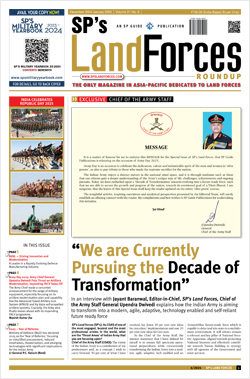INDIAN ARMED FORCES CHIEFS ON OUR RELENTLESS AND FOCUSED PUBLISHING EFFORTS

The insightful articles, inspiring narrations and analytical perspectives presented by the Editorial Team, establish an alluring connect with the reader. My compliments and best wishes to SP Guide Publications.

"Over the past 60 years, the growth of SP Guide Publications has mirrored the rising stature of Indian Navy. Its well-researched and informative magazines on Defence and Aerospace sector have served to shape an educated opinion of our military personnel, policy makers and the public alike. I wish SP's Publication team continued success, fair winds and following seas in all future endeavour!"

Since, its inception in 1964, SP Guide Publications has consistently demonstrated commitment to high-quality journalism in the aerospace and defence sectors, earning a well-deserved reputation as Asia's largest media house in this domain. I wish SP Guide Publications continued success in its pursuit of excellence.
- The layered Air Defence systems that worked superbly, the key element of Operation Sindoor
- Operation Sindoor | Day 2 DGMOs Briefing
- Operation Sindoor: Resolute yet Restrained
- India's Operation Sindoor Sends a Clear Message to Terror and the World – ‘ZERO TOLERANCE’
- Japan and India set forth a defence cooperation consultancy framework, talks on tank and jet engines
- Lt General Pratik Sharma takes over Command of Indian Army's Northern Command
- Major General Lisamma P.V. assumes the appointment of ADG, MNS
- Uzbekistan's progressive transformation is a bright spot in Central Asia; boosts cultural ties with India
- Terrorist Attack in Pahalgam in Kashmir: Unfolding a long surgical war against PAK
Tackling Airborne Threats

The Raytheon-Kongsberg team will offer India a set of solutions, or system of systems, tailored to each requirement
The Indian Ministry of Defence has not yet released the requirement for quick reaction surface-to-air missile (QRSAM), and hence it would be premature to specify an exact solution. However, some insights can be provided into the approach that the Raytheon-Kongsberg team will take in response to any requirement released by India.
Airborne threats today are many and varied. They range from the familiar high speed fixed wing fighters and bombers to hovering helicopters, low radar cross section cruise missiles, loitering unmanned aerial vehicles (UAV), and lethal tactical ballistic missiles (TBM). Combine this broad array of threats with the wide range of assets to be protected, and the force commander faces a daunting challenge. The capabilities required to protect a manoeuver force are different from those required to protect a port, population centre or an airbase. The capability required to defeat a large fighterbomber is significantly different from that required for a TBM. It is for this reason that the Raytheon-Kongsberg team will offer India a set of solutions, or system of systems, tailored to each requirement.
The key to a successful air defence solution is to employ a layered air defence strategy (Figure 1) that incorporates a mix of weapons systems in order to counter this diverse air threat. Advanced countermeasure capabilities and multi-dimensional saturation attacks require a defensc in depth. The Raytheon-Kongsberg concept for an air defence system for Indian armed forces offers an integrated air defence system, providing point, area and manoeuver force defence with common sensor coverage and an integrated command and control (C2) architecture. Based on open hardware and software architectures, this C2 design will incorporate existing capabilities of the Indian armed forces and will easily add new capabilities in the future, regardless of the manufacturer.
The fire distribution centre (FDC) configured as battery mobile command post (BMCP) is the centerpiece in this state-of-theart C2 system that utilises extended communications and data link capabilities. The unique battalion net data link (BNDL) established between the FDCs provides improved combined sensor coverage and increased ECM survivability. The netting of FDCs enables complete situational awareness by creating and exchanging a local air picture (LAP), air space control measures and integration of external recognised air pictures (RAP); consequently producing a single correlated air picture (SCAP). The FDC C2 solution represents the latest in modern military air defence technology based on open architecture standards. This open architecture enables continuous system capabilities evolution through the addition of elements and modules, as new technology becomes available, providing unlimited future growth potential. This C2 element can be easily and quickly reconfigured to control operations at all levels of command from basic fire unit through battalion, regiment, brigade, or division (Figure 2). Commonality of hardware and software simplifies the challenges of training and sustainment across the air and missile defence forces.
The Raytheon-Kongsberg team will offer India a set of solutions, or system of systems, tailored to each requirement. A network of sensors supplying data to this common command and control architecture provides a single correlated air picture (SCAP) that enables positive airspace and battle management, integrating and optimising weapon systems performance. C2 integration with multiple adjacent sensors and higher-echelon units, as well as the Indian Integrated Air Command and Control Systems defence structure, will ensure a robust and effective air defence architecture.





